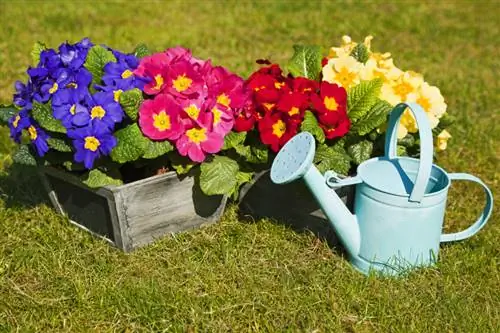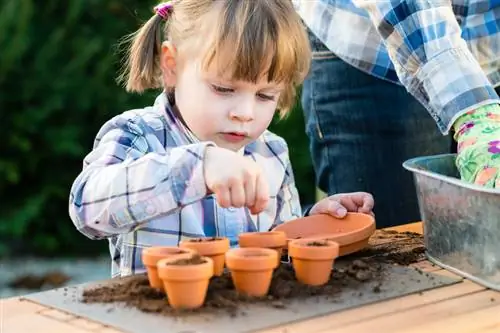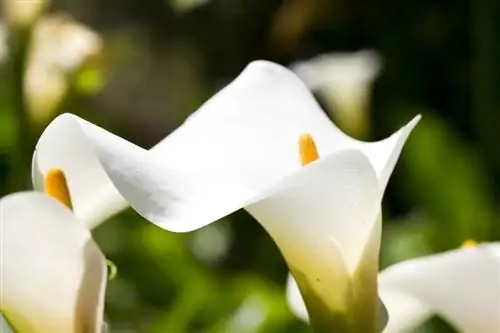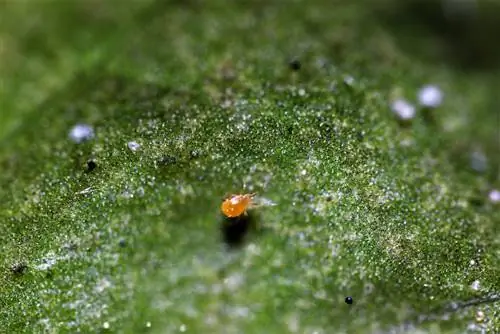- Author admin [email protected].
- Public 2023-12-25 17:45.
- Last modified 2025-01-23 11:22.
The primrose spreads colorful floral flair everywhere in the garden and on the windowsill. Thanks to its breathtaking diversity and frugal undemanding nature, the flower cannot be missing from our green kingdom. Find out here how much gardening attention the cowslip requires.

How do you properly care for primroses?
Primroses thrive best in partially shaded locations in good garden soil and temperatures between 5 and 15 degrees Celsius. They should be kept constantly moist and fertilized organically every 2 weeks during the flowering period. Regular removal of wilted material prolongs their flowering.
Planting primroses correctly
Plant a primrose that you have purchased or grown yourself like this:
- In the spring, thoroughly loosen the completely thawed soil
- Dig small pits at a distance of 15-30 cm, with twice the volume of the root ball
- Optimize the excavation with peat, compost and horn meal
- Unpot the flower, plant it, water it well and mulch it
Do not plant the primrose deeper than in the growing container and press the soil with your hands without compacting it excessively.
Care tips
A look at the care protocol makes it clear why the primrose is a flower suitable for beginners. Treat a cowslip to these gifts:
- Keep the substrate constantly moist
- Use soft water for water
- Spray the foliage repeatedly
- Cleaning up wilted and faded things
- During the flowering period, fertilize organically every 2 weeks
- Transplant in the bed every 2 years, in the pot every spring
Since the flower is only moderately hardy, it is protected outdoors from leaves, needles, reed mats or compost. Primroses in pots spend the cold season on the bright windowsill at 5 to 15 degrees Celsius. The substrate should not dry out.read more
Which location is suitable?
If you assign the flower to a semi-shady location, the primrose will thank you with busy blooming. If you delve deeper into the multifaceted biodiversity, you will discover specialists for sunny locations as well as experts for shady garden corners. Some examples for clarity:
- Auricle (Primula auricula): sunny locations, as long as the soil is fresh and moist
- High cowslip (Primula eliator): partially shaded location
- Flower primrose (Primula bulleyana): sunny to partially shaded places
- Bell primrose (Primula florindae): shady locations
- Deciduous primrose (Primula frondosa): prefers shade
If the temperature range is from 5 to 15 degrees Celsius, the flower feels right at home. Therefore, a place on the window sill in the bedroom is more likely to be considered in the house than in the cozy, warm living room.read more
The correct planting distance
The precise planting distance depends on the species and variety chosen. You are exactly right with a value that fluctuates between 15 and 30 centimeters.
What soil does the plant need?
The frugal flower thrives in any good garden soil. In order to experience a primrose at its best, it is worth taking a look at its detailed requirements for the soil. Based on the type, there are differences to take into account. The following overview reveals the details:
- Alpine auricules thrive in calcareous, loamy-sandy soil
- Ball primrose blooms particularly well in slightly acidic substrate
- Swamp Primrose likes very moist and acidic soil
- Flower primrose does its best in loamy, humus-rich soil, rich in peat and with good water storage
What is the best time to plant?
The best planting time for primroses is from March to May, in completely thawed soil. Another time window opens in September if you want to plant hardy species and varieties.
When is flowering time?
Skillfully combined, you can enjoy blooming primroses all year round. There are more than 500 species of cowslips for every season. The following compilation may serve as inspiration:
- Cushion primrose blooms from February to April
- Alpine Auricula: blooms from April to June
- Flower primrose: flowering from June to August
- Head primrose: flowering period from July to November
Planted in the pot in autumn, the ball primrose conjures up a splash of color on the winter windowsill from December to February.
Cut primroses correctly
The primrose does not receive any pruning in the actual sense. However, cut out any wilted leaves from the rosette. In addition, the flowering period is extended by weeks if the flower is cleaned thoroughly every few days. Don't forget gloves!
Watering primroses
The primrose happily spreads its roots in the slightly moist substrate. Dryness of the bales inhibits the abundance of flowers, as does waterlogging. Therefore, do not leave water in the coaster for a long time. The flower loves to be watered and sprayed with soft, collected rainwater. Increased humidity at moderate temperatures strengthens the vitality of the small flowering beauty.
Fertilize primroses properly
Similar to the flowering period, the primrose is grateful for a well-measured ration of fertilizer. In the bed, mature compost, horn shavings or guano granules meet the requirements. Plant manure or mineral-organic liquid fertilizer is used in the bucket every two weeks to provide nutrients. Outside of flowering, no fertilizer is usually necessary.
Diseases
Regardless of the sometimes high poison content, the primrose does not always know how to defend itself against the following diseases:
- Powdery and downy mildew: treat by spraying a milk-water solution in a ratio of 1:9
- Ramularia leaf spot: fight with Neudovital or spray with horsetail tea
- Grey mold: Isolate flower, cut off diseased parts, powder repeatedly with rock dust
Pests
If uninvited guests colonize a primrose, they are usually the usual suspects in the garden and room.
- Black weevil: Work neem seeds into the soil, set up traps with nematode gel
- Aphids: fight with 15 ml of dissolved curd soap in 1 liter of water, sprayed every 2 days
Swarms of fungus gnats often cavort in the potting soil of primroses in pots. Pot out the flower and add a layer of quartz sand to the fresh substrate in the upper third. From then on you only water the primrose from below and the plague is over.
Wintering
The neat flower is largely frost-resistant and tolerates temperatures down to -5 degrees Celsius in the bed without complaint. However, the following protection is recommended in rough locations:
- Cover the deciduous flower with reed mats, pine fronds or leaf mold
- Protect wintergreen primroses from frost with garden fleece or a thick layer of newspaper
Primroses in pots move to winter quarters at temperatures below freezing. On the bright, not full-sunny windowsill, the flower gets through the cold season he althily at 5 to 15 degrees Celsius. Do not let the root ball dry out and do not apply fertilizer until March.
Propagate primroses
There are two uncomplicated methods of propagating primroses to choose from. Every transplanting and repotting in spring is a good opportunity to divide the root ball. If you then plant a segment with at least 2 buds, a new flower will grow from it within a short time. Sowing the seeds is more exciting. Here's how to do it:
- In January/February fill small pots with peat sand
- Sow the seeds, sieve thinly with sand and moisten
- Equip each seed container with a transparent hood
- Place on the balcony or in an unheated greenhouse at 0 to 4 degrees Celsius for 4-6 weeks
After the seeds have been exposed to a cold stimulus, place them in a partially shaded location where germination begins at 10 to 15 degrees. During this time, keep the sowing slightly moist and do not apply any fertilizer.
Primroses in a pot
In the pot, the primrose unfolds its flower festival particularly impressively in a partially shaded, not too warm location. Add a handful of rhododendron soil or peat to the substrate and create a drainage layer of clay shards at the bottom of the pot. How to care for the flower expertly:
- Only water when the substrate has dried
- During the flowering period, fertilize liquidly every 2 weeks
- In winter, place bright and cool at 5 to 15 degrees Celsius
Use only lime-free watering water and spray the flower from time to time. Repeated cleaning extends the flowering period by many days or even a few weeks.
Is primrose poisonous?
Exercise caution when handling primroses, as some species contain highly toxic contents. Explicitly, the cup primrose (Primula obconica) and the cowslip (Primula elatior) are permeated with toxic primin. This natural substance can cause severe irritation when it comes into contact with the skin. Intentional or unintentional consumption has life-threatening consequences for humans and animals. The flower should therefore be avoided within the reach of children and pets.
Primroses not blooming
If a primrose refuses to bloom, the deficiency results from various causes. The most common triggers are:
- Location too cold or too warm
- Bright midday sun
- Drought stress or waterlogging
- Nitrogen overfertilization
- Calciferous irrigation water
Brown leaves
Brown leaves are considered a typical symptom of Ramularia primulae, a fungal disease that specifically affects primroses. It begins with yellow leaf spots that turn brown and spread throughout the foliage. In the early infestation stage, immediate removal of the diseased leaves can save the flower. Neudovital (€28.00 at Amazon) from Neudorff, a well-known preparation against fungal infections on fruit and roses, acts as a control agent.
Yellow leaves
All primroses react to substrates that are too wet and a location that is too cold with yellow leaves. Therefore, only water after a thumb test and do not leave water standing in the saucer. Ideally, you should cultivate the flower at temperatures between 5 and 15 degrees Celsius.
How do I transplant correctly?
Repeated transplanting of primroses makes a valuable contribution to maintaining the flower's vitality and willingness to bloom. Follow this schedule to do it right:
- Dig up, divide and transplant primroses in the bed every 2 years
- Repot flower in pot every year in early spring
Transplanting and propagating go hand in hand with a primrose. At the same time, take the opportunity to pamper the flower with a fresh treatment in the form of fresh soil, enriched with a portion of compost and horn shavings.
The most beautiful varieties
- Gold Lace: a gold-lined cowslip with mahogany-colored petals in April and May
- Rubin Auslese: magnificent globe primrose with ruby red flower heads from March to May
- Millers Crimson: the primrose impresses with carmine-red flowers from May to July
- Carnival Primrose: enchanting cushion primrose with pink, yellow, white and purple flowers from February
- Red Hot Poker: stunning orchid primrose with candle-shaped flowers all summer long






